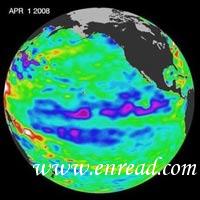| ||||||||||||||||||||||||||||||||||||||||||||||||||||||||||||||||||||||||||||||||||||||||||||||||
|
This image from the U.S.-French Jason oceanographic satellite released by NASA April 21, 2008 depicts1 one of the strongest La Ninas in many years as it is slowly weakening but continues to blanket the Pacific Ocean near the equator. The La Nina weather anomaly will persist into the spring of 2009 but should gradually weaken during that period, the U.S. Climate Prediction Center said on Thursday. In a monthly update, the CPC said "a majority of the model forecasts ... indicate a gradual weakening of La Nina through February-April 2009, with an eventual2 transition to neutral conditions." CPC is an office under the National Oceanic and Atmospheric3 Administration (NOAA). The body said La Nina will last into spring of this year. La Nina literally4 means "little girl" in Spanish. It results in cooler-than-normal waters in the Pacific Ocean. The more famous El Nino weather phenomenon has the opposite effect. Scientists believe La Nina spurs hurricane formation in the Atlantic basin by hindering wind shear5 that breaks up storms as they form. CPC said the potential impact of La Nina during February to April 2009 include above average precipitation in the Ohio and Tennessee valleys and below average rainfall in the southwestern and southeastern United States. It said the other impacts are below average temperatures in the Pacific Northwest and above average temperatures in much of the southern United States. Indonesia, the most populous6 country in Southeast Asia and a major producer of coffee, cocoa, palm oil and other agricultural products, could get above average precipitation, the CPC added. El Nino -- which means ' little boy' in Spanish -- wreaks7 havoc8 in weather patterns across the Asia-Pacific regions. The most devastating9 struck in 1997/98 when it caused withering10 drought in Australia and Indonesia while spawning11 floods in Peru and Ecuador. It was named after the Christ child by Latin American anchovy12 fishermen in the 19th century who first took note of the weather anomaly. 美国气候预测中心于上周四称,“拉尼娜”气候现象将持续至2009年春季,但在此期间其影响将逐渐减弱。 美国气候预测中心在其月度刊物中称,“多数模型预测结果显示,拉尼娜现象从今年2月至4月期间将逐渐减弱,最终将过渡为正常状态。 隶属于国家海洋和大气局(NOAA)的美国气候预测中心称,拉尼娜现象将持续至今年春季。 “拉尼娜”(La Nina)在西班牙语中的意思为“小女孩”。这种气候现象会导致太平洋海水温度低于正常水平,而更为著名的“厄尔尼诺”现象所导致的后果则正好相反。 科学家认为,由于“拉尼娜”阻碍了可破坏暴风雨形成的风切变,所以它会促使大西洋洋面形成飓风。 美国气候预测中心称,2009年2月至4月间,“拉尼娜“现象的潜在影响包括:俄亥俄州和田纳西州山谷地区降水量将高于平均水平,而美国西南部和东南部地区的降水量将低于平均水平。 其他影响包括,西北太平洋地区气温将低于平均水平,美国南方大部分地区气温将高于平均水平。 美国气候预测中心称,在此期间,东南亚地区人口最密集的国家印度尼西亚的降水量将高于平均水平。印度尼西亚是咖啡、可可、棕榈油和其它农作物的主要生产国。 在西班牙语中意为“圣婴”的“厄尔尼诺”现象则对亚太地区的气候造成了严重影响。最具破坏性的“厄尔尼诺”事件发生于1997年至1998年间,当时这一气候现象导致澳大利亚和印度尼西亚出现严重干旱,秘鲁和厄瓜多尔则遭遇了洪灾。 “厄尔尼诺”得名于19世纪,当时拉丁美洲一名捕捞凤尾鱼的渔民最早注意到了这种天气异常现象,并将之命名为“圣婴(El Nino)”。 Vocabulary: weather anomaly:天气反常 点击  收听单词发音 收听单词发音
|
||||||||||||||||||||||||||||||||||||||||||||||||||||||||||||||||||||||||||||||||||||||||||||||||
- 发表评论
-
- 最新评论 进入详细评论页>>




